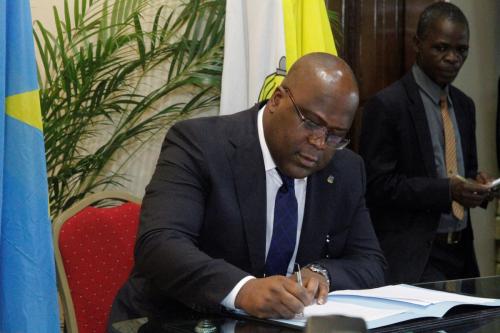Energy reform presents a formidable task for Mexico. President Enrique Peña Nieto has successfully introduced major constitutional reforms since taking office on December 1 last year: quality education, banking, anti-monopoly in telecommunications and labor, in which he supported his predecessor’s proposal. Reform of political institutions to allow, among other things, the re-election of officials at all levels, except president, is due to be debated in Congress in the next few weeks. Furthermore, Peña Nieto introduced fiscal changes which failed to gain acceptance as a true reform. They should have raised significant revenue if the most challenging of the reforms was to succeed, namely energy.
Energy Reform Poses a Historical Challenge for Mexico
The Mexican constitution of 1917 decreed that the subsoil and its contents belonged to the Mexican state. This assertion, made during Mexico’s prolonged and violent civil war has retained quasi-religious significance for the Mexican people. The early exploration and production of oil by Royal Dutch Shell, Jersey Standard and Standard Oil of California (now Chevron) resulted in Mexico becoming the world’s second largest oil producer in the 1920s. However, foreign ownership provoked much popular resentment, leading to President Lázaro Cárdenas’s announcement on March 18, 1938 to nationalize all privately held oil fields and wells. He provided adequate compensation to ensure that relations with both the United States and British governments remained stable, and he avoided the withdrawal of other foreign investors from Mexico. In the constitutional reforms of 1938 and 1940 to Articles 27 and 28, Cárdenas balanced the interests of both state and private persons, such that capital, management and productive techniques could be used for the benefit of the Mexican state. This search for equilibrium lies at the heart of President Peña Nieto’s efforts to reform the energy sector.
Lázaro Cárdenas based these constitutional changes on two principles: first, the state’s exclusive dominion over the subsoil together with the right to contract with third parties in exploration and exploitation of hydro-carbons; and second, the state’s ability to allow concessions on other petroleum industrial activities, such as refining, pipelines and distribution of gasoline.[1] More restrictive amendments to Articles 27 and 28, as well as the secondary or implementing legislation, followed in 1960 and 1983. These reserved to the national oil company, Petróleos Mexicanos (PEMEX), the exclusive right to manage all petroleum industrial activities and prohibited contracts with third parties. Private contracting was allowed into the service sector through the reforms of 2008, but the state monopoly continued to control exploration and exploitation of oil and gas, the construction of the refinery in Hidalgo and the maintenance of the pipelines and distribution of gasoline.
Now, opportunities for greater extraction of both oil and gas require significant new investment, shared risks, and new technologies. Without that, Mexico will continue to depend upon importing 49 percent of its gasoline and 33 percent of its diesel. Of the 2.5 million barrels of crude oil produced each day (bpd) in 2012, PEMEX could refine 1.2 million bpd. The remainder was sent to U.S. Gulf Coast refineries. Imports of natural gas have increased from 3 percent in 1997 to 33 percent in 2012, due to the lower price for North American natural gas. Also, Mexico imports 80 percent of the petrochemicals used throughout the country. Without the juridical framework to allow new investment, new technologies and shared risk, Mexico will become a net importer of hydrocarbons. This is the wake up call to traditionalists who recall the nationalistic fervor of 75 years ago.
However, national pride in the ownership of its “black gold” requires an extensive education campaign; and Mexican citizens deserve an honest assessment of their depleted national asset. PEMEX is both an emblem of the nation’s wealth and a behemoth riddled with corruption. Under PEMEX, yields from Cantarell, the principal oil field, have diminished and Mexican oil and gas production has fallen from its apogee in 2005 of 3.425 million bpd to 2.548 million bpd in 2012. Instead of using PEMEX revenues to invest in new exploration, technology and maintenance, these funds are diverted to supporting approximately one third of Mexican government expenditures. Currently PEMEX only reinvests 15 percent of its total portfolio in exploration activities, far below the level of Brazil’s PETROBRAS and its other international competitors. We may conclude that PEMEX fails to act as a for-profit corporation, but accepts the role as a government agency which profits are invested in the state’s social and infrastructure programs, thus relieving Mexican citizens of paying high taxes.
Today, PEMEX is broke with losses of US$3.017 billion in the 3rd quarter of 2013.[2] Moreover, 2013 operations and maintenance costs increased by almost 25 percent compared to 2012.[3] Subsidies to consumers of oil, gas and electricity amounted to US$6.46 billion in the 3rd quarter of 2013, surpassing the $3.76 billion subsidy budgeted for all of 2013.[4] To reduce imports and meet Mexican industrial and transportation needs, PEMEX must produce half a million more bpd by 2018. The case for energy reform is stark and Mexico’s political leaders have put forward distinct proposals.
Proposals from the Right: PAN
The most ambitious plan comes from the center-right party, the PAN. Production sharing contracts would become legal, in return for which participating companies would pay royalties, taxes and licenses. PEMEX would become autonomous from the government and be regulated by a newly formed, National Hydro Carbon Commission (CNH). PAN leaders would break up the public monopoly both on PEMEX and on electricity generation and distribution held by the state power company, Comisión Federal de Electricidad (CFE). The PAN bill would reduce PEMEX outstanding debt through the issuance of new debt known as Citizen Bonds, as well as hybrid securities to be sold to private investors. Finally, the PAN bill would eliminate the five labor union seats on the PEMEX Board of Directors.
Proposals from the Left: PRD
There is no single proposal from politicians within the PRD. Instead, several factions hold distinct policies. Cuauhtémoc Cárdenas, the son of President Lázaro Cárdenas has become the standard bearer for the PRD in the absence of specific proposals from the more vocal Left. Cárdenas stands against private investment in PEMEX. Instead, he would modify the tax system so as to increase PEMEX resources and its capacity to refine. He seeks to introduce transparency into the operations of PEMEX and root out corruption, both of which have affected the capability of the “paraestatal” to compete with other national oil companies. Cuauhtémoc Cárdenas is the most prominent and respected politician opposing the current energy reform. In this, he has aligned himself with the former mayor of Mexico City and contender for the PRD leadership in the presidential race for 2018, Marcelo Ebrard.
The most radical opposition comes from Andrés Manuel the presidential candidate from the PRD who lost in 2006 to PAN’s Candidate Felipe Calderón. He and his newly formed political movement, MORENA have rejected opening the energy sector to private investment in whatever form it might take. López Obrador would reclaim the support of voters, in their millions, through a nation-wide campaign to reject the current energy reform. To carry this out, he calls for a consulta popular (national consultation) which requires, under Article 35 (VIII) of the Mexican constitution, that he gain signatures from at least 2 percent of those registered in the electoral list; currently estimated to equal 1,700,000 signatures. Furthermore, enactment of any changes, deemed to be of national transcendency, requires a majority vote in favor in both legislative bodies. López Obrador, may obtain sufficient signatures, but the strong majority of PRI and PAN members in both the Lower House and the Senate make it extremely unlikely that he will achieve the majority vote in congress.
President Peña Nieto as Broker
President Peña Nieto leads a coalition of diverse opinions within the governing PRI party. Some PRI members welcome production sharing contracts, as proposed by the center-right PAN. A few would even contemplate the format favored by the international oil companies (OICs), namely concessions, despite the fact that Peña Nieto has rejected this method. (Concessions grant some ownership rights in the resource and allow oil companies to book reserves; a critical accounting feature for international oil companies.) All the while, the more traditional PRI supporters are reluctant to see private investment in PEMEX. For decades the old timers within the PRI have rejected private investment in PEMEX, holding onto sovereign ownership of the petroleum reserves. Their willingness to change — be it grudgingly — reflects the political influence of a new generation of PRI leaders who won back the presidency after 12 years in the wilderness. However, with pressure from the Left which had taken to the streets of Mexico City in support of the education reform, Peña Nieto decided to support the more cautious “profit sharing” contracts in the exploration and exploitation of oil and gas fields, while allow concessions in the downstream industrial activities, such as refining, development and management of pipelines and distribution. In doing so, Peña Nieto recalled the principles enunciated by President Lázaro Cárdenas, namely balance the interest of the state with the need to utilize the capital, shared risk and technology of the private sector.
Constitutional Language for Energy Sector Reforms
On August 12, Peña Nieto announced the proposed constitutional reforms of the energy sector. The principal purpose of the reforms is to eliminate restrictions and introduce as much flexibility as possible in designing juridical methods for engaging the private sector through contracts in exploration and production of gas and oil, including future sources of shale gas. The proposed Constitutional amendments are specific on one critical issue: the state will grant no concessions in the exploration and exploitation of Mexico’s hydro carbon resources. However, no such prohibition exists for the related petroleum industrial activities. The Federal government is to determine the management of the value chain in hydrocarbons — otherwise known as down-stream industrial activities — through its secondary or implementing legislation. This makes the drafting of these laws critically important. It is worth noting that the Federal government, not PEMEX is given this responsibility, which in reality grants the Ministry of Finance an important role in drafting the legislation.
How Can Mexico Successfully Reform Its Energy Sector?
The secondary legislation must set out the shape of the contracts offered to private parties, most notably international oil companies and service companies. It is expected to outline a comprehensive plan that will identify the role of PEMEX, as well as the Ministry of Finance which collects the revenue on behalf of the Mexican state. Secondary legislation will need to establish the mechanisms for valuing the cost of each oil field, whether an old on-shore well, or a projected off-shore deep water bloc. It will need to set out the procedures for establishing operating costs, recuperation costs, and the percentages due to PEMEX and due to the Mexican state. In short, the monopoly will be asked to accept the real cost of oil and gas production through international market evaluation of its current and future assets. These tasks are not easy and require time. Former Director General of PEMEX Adrián Lajous calculates that ten years is needed before PEMEX begins to see the benefit of these reforms.
Whether the institution, PEMEX is restructured to create anefficient and effective oil and gas company remains uncertain. The results of a recent survey, commissioned by the Chamber of Deputies, found that 75 percent of those polled considered that the management of PEMEX was bad, or fair.[5] Only 17 percent considered it good. Furthermore, 88 percent of those polled thought that “very much” or “a certain amount” of corruption existed within PEMEX. Consequently, current popular would support the reform of PEMEX. However, the union of PEMEX workers, representing 101,000 workers out of a total of 150,000 workers, is a powerful institution which will resist changes that reduce its role. Any reform to PEMEX must take into account both the union and its pension fund so as to minimize their capacity to block the reforms.
The principal challenge that lies ahead is the right balance between guarding the underlying resource for the benefit of Mexican citizens and drafting legislation that will attract private investors to join with PEMEX in undertaking exploration and production in deep waters, as well as extractive techniques to reuse old wells and begin to exploit extensive reserves of shale gas near the Texan border. In order to gain support for this most important project, Peña Nieto has to launch a concentrated effort to educate Mexican citizens on the need to allow private investment in the energy sector. To date, the government has acted defensively, rejecting the call for greater information and debate. That has to change if citizens are to understand why the President seeks to reform the energy sector.
Meantime, the PRD has dug in to resist private investment in PEMEX. The struggle will be fierce and national. This is a battle that U.S. politicians and oil executives should stay out of because the prospect of renewed North American participation in the oil sector is an anathema to Mexican voters and their political leaders. We must hope for political debate based on the reality of Mexico’s diminishing hydrocarbon resources and its capacity to finance new exploitation. No one wishes this battle to turn violent and disrupt ordinary lives in Mexican towns and along the pipelines. A healthy, political and national debate should occur over several weeks, if not months. In the meantime, Mexicans have come to accept the reality of a global and competitive world. Part of that reality is laying the legal groundwork for private investment, risk and talent in Mexico’s energy sector.
[1] For an analysis of President Lázaro Cárdenas’s constitutional amendments and their rationale see President Peña Nieto’s “Initiative to Reform the Constitution,” August 12, 2013.
[2] http://spanish.xinhuanet.com/iberoamerica/2013-10/26/c_132831476.htm
[3] http://eleconomista.com.mx/industrias/2013/10/27/pemex-llega-tercer-trimestre-perdida
[4] http://www.cnnexpansion.com/economia/2013/11/01/gasolina-magna-supera-los-12-pesos
[5] Dr.Rafael Arestegui at CESOP [Centro de Estudios Sociales y de Opinión Pública de la Cámara de Diputados] July, 2013. http://goo.gl/ADACyf.
The Brookings Institution is committed to quality, independence, and impact.
We are supported by a diverse array of funders. In line with our values and policies, each Brookings publication represents the sole views of its author(s).



Commentary
Op-edMexico’s Most Critical Challenge: Energy Reform
November 20, 2013